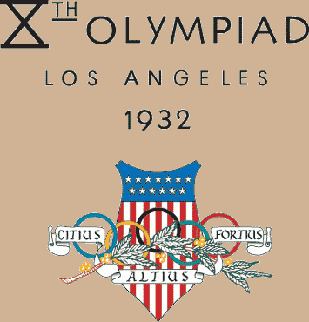Nations participating 37 Opening ceremony July 30 | Closing ceremony August 14 | |
 | ||
Athletes participating 1,332 (1,206 men, 126 women) | ||
The 1932 Summer Olympics, officially known as the Games of the X Olympiad, was a major worldwide multi-athletic event which was celebrated in 1932 in Los Angeles, California, United States. No other cities made a bid to host these Olympics. Held during the worldwide Great Depression, many nations and athletes were unable to pay for the trip to Los Angeles. Fewer than half the participants of the 1928 Summer Olympics in Amsterdam returned to compete in 1932. Even U.S. President Herbert Hoover skipped the event.
Contents
- Host city selection
- Highlights
- Medals awarded
- Demonstration sports
- Art
- Venues
- Participating nations
- Medal count
- References
The organizing committee put no record of the finances of the Games in their report, though contemporary newspapers reported that the Games had made a profit of US$1,000,000.
Host city selection
The selection process for the 1932 Summer Olympics consisted of one bid, from Los Angeles, which ultimately hosted the games. The selection was made at the 23rd IOC Session in Rome, Italy, in 1923.
Highlights
Medals awarded
117 events in 20 disciplines, comprising 14 sports, were part of the Olympic program in 1932. In one of two Equestrian jumping events (team competitions) no medals were awarded. The number of events in each discipline is noted in parentheses.
Demonstration sports
Art
See Art competitions at the 1932 Summer Olympics for details of the art competitions held at the games, in which medals were awarded in five categories (architecture, literature, music, painting, and sculpture), for works inspired by sport-related themes.
Venues
Fifteen sports venues were used for there 1932 Summer Olympics. In order to control cost in the wake of the Great Depression, existing venues were used. They included two golf courses, two city parks, three public highways, and a city road. The Swimming Stadium was the only new venue constructed for these games; it was built with temporary wooden seating. The Rose Bowl, constructed in 1921, was made into a temporary velodrome for track cycling events with the help of a French engineer under the auspices of the Union Cycliste Internationale (UCI). The Los Angeles Memorial Coliseum, constructed in 1923, was used as the Olympic Stadium;). The Olympic Auditorium was constructed in 1924 in preparation for Los Angeles being awarded the Games; it was modified to meet the specifications of the boxing, weightlifiting, and wrestling federations. Long Beach Marine Stadium was created in 1925 when Alamitos Bay was dredged, then further dredged seven years later in time for the 1932 Games. Elysian Park, the oldest city park in Los Angeles, was founded in 1886, and has been part of the Los Angeles Police Department (LAPD) training academy since 1925. The Riviera Country Club opened in 1926 as the Los Angeles Athletic Club and was renamed Riviera by the time of the 1932 Games. The swimming stadium, constructed adjacent to the Coliseum in 1932, was intended to be a temporary structure. Riverside Drive, Los Angeles Avenue, Vineyard Avenue, and the Pacific Coast Highway were common driving routes in California at the time of the 1932 Games.
The Coliseum was the first home for the Dodgers Major League Baseball (MLB) team when it moved from Brooklyn, New York in the 1958 season. The following year, it hosted the MLB All-Star Game and the World Series. Once Dodger Stadium was completed in 1962, the Dodgers moved there where they have been since 2010. The Los Angeles Rams National Football League (NFL) team used the Coliseum as its host stadium from 1946 to 1980 when it moved to Anaheim, located southeast of Los Angeles. It also hosted what would become known as Super Bowl I in 1967. Even the American Football League's Chargers used the Coliseum as a venue in 1960 until their move to San Diego the following year. The Coliseum continues to host USC Trojans football games to this day, and also hosted UCLA Bruins football for a number of years. The Rams return to the Coliseum in 2016.
The track constructed in the Rose Bowl was given to the Tournament of Roses Association upon completion of the 1932 Games. The Bowl was expanded between 1932 and the 1984 Summer Olympics three times, increasing its capacity from 83,000 in 1931 to 104,594 in 1972. It hosted Super Bowl XI in 1977, where the Oakland Raiders defeated the Minnesota Vikings 32-14. It is the current home of UCLA Bruins football and the Rose Bowl Game, and was the home of the L.A. Galaxy soccer team for a number of years.
Elysian Park's shooting range was left intact for the LAPD to use. Sunset Fields Golf Club was renamed Brentwood Country Club in 1941 and is still in use as of 2010. All of the road courses were returned to public usage after the Olympics. The Olympic Auditorium continued to be of use for boxing and roller derby events until June 2005 when it was bought to be used as a megachurch. Los Angeles Harbor continues to be a major sea port in the Western United States, employing 919,000 people and generating USD 39.1 billion in annual wages and tax revenues as of 2007. The Riveria Country Club continues to host golf events, hosting the 1948 U.S. Open and the PGA Championship in 1983 and 1995. The Swim Stadium was renovated in 2003 and continues to be in use as of 2010.
For the 1984 Summer Olympics, the Coliseum and the Rose Bowl were used as venues.
Participating nations
A total of 37 nations were represented at the 1932 Games. Colombia made its first appearance at the Olympic Games, and the Republic of China (with a single athlete) competed for the first time after its failed appearance at the 1924 Games.
Medal count
These are the top ten nations that won medals at the 1932 Games.
